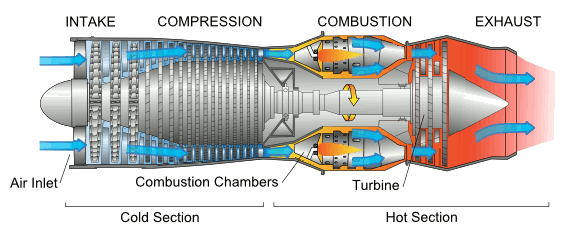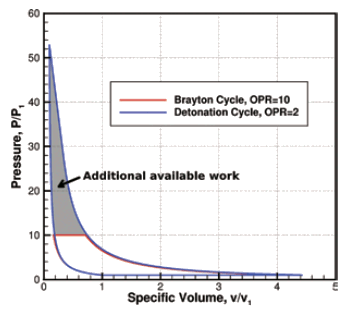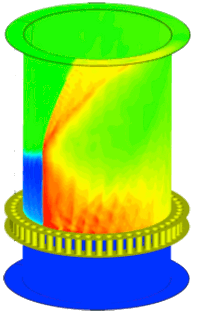Detonation Engine
December 5, 2012
I worked on a variety of
gas turbine engine components during my career in
industrial research. The principle behind the gas turbine engine is so simple that it lends itself to many applications, from
motors for medium-sized
electric generators, to engines for
tanks,
battleships, and
very large aircraft. Adding
complexity to the basic design allows creation of high performance engines for
military aircraft.

Schematic diagram of a gas turbine engine. Once the engine is started, the compressors in the cold section compress the intake air, which is mixed with fuel in the hot section combustor. The hot gases drive the turbine section. As can be imagined, there's a lot of science and engineering that goes into turbine engine research. (Illustration by Jeff Dahl, via Wikimedia Commons)
The gas turbine engine works well in its applications, but there's always room for improvement, especially where
fuel efficiency is desired. Gas-turbine engines are used to provide
propulsion and
electricity for
ships, and it takes a lot of fuel to propel a battleship across an
ocean. Fortunately, just lurking around the
technology corner, is the more fuel efficient
detonation engine.
The fundamental difference between a detonation engine and a gas turbine engine is
compression. The gas turbine engine has a huge array of
compressor blades and stators to handle this task. A detonation engine, as its name implies, uses a
detonation wave to compress the fuel-air mixture. Detonation engines don't supply power in a continuous fashion, like gas turbine engines. To get a quasi-continuous power output, you need to renew the detonation again and again.

PV curves for the gas turbine engine Brayton cycle and the detonation cycle, showing the enhanced efficiency obtainable.
In this comparison, the operating pressure ratio (OPR) is 10 for the Brayton cycle, and 2 for the detonation cycle.
(Fig. 1 of ref. 2).[2)]
Detonations are nearly a
constant volume process, so they generate high
pressures that can do
work without any compression. Elimination of the compressor section, and its array of moving parts, adds reliability. This advantage, however, comes at a price. Air and fuel inlet
valves need to
actuate at high rates to get a continuous series of detonations. There's also a potential
noise problem, since you're trading the mostly
white noise of a turbine engine for a continuous
tone of the detonation engine.
Scientists from the
Laboratory for Computational Physics and Fluid Dynamics of the
United States Naval Research Laboratory are using
computational techniques in the study of a variant of the detonation engine, the rotating detonation engine (RDE).[1] Their motivation is simply stated. The
US Navy presently fields about 430 gas turbine engines on 129 ships, and these engines require about two billion dollars of fuel each year. RDEs could save about 300-400 million dollars per year in fuel cost.[1]
The rotating detonation engine addresses the problems of a basic detonation engine by causing the detonation to propagate
azimuthally around an
annular combustion chamber, as shown in the
computer model, below. The naval trend is towards an all-electric ship propulsion system, so the rotating detonation engine would drive a hefty electrical generator.

A computer model of a rotating detonation engine.
The detonation, as shown in red, propagates azimuthally around an annular combustion chamber.
See refs. 2-3 for an overview of detonation wave engine technology.[2-3]
(U.S. Naval Research Laboratory image).[1)]
![]()
References:
- Donna McKinney, "Navy Researchers Look to Rotating Detonation Engines to Power the Future," Naval Research Laboratory Press Release, November 2, 2012.
- D.A. Schwer and K. Kailasanath, "Rotating Detonation-Wave Engines," NRL Review, U.S. Naval Research Lab (2011).
- F. Falempin, "Continuous Detonation Wave Engine," NATO Report RTO-EN-AVT-150, March 26, 2008.
Permanent Link to this article
Linked Keywords: Gas turbine engine; research and development; industrial research; >motor; electric generator; tank; battleship; Boeing 787 Dreamliner; aircraft; complexity; stealth aircraft; military aircraft; schematic diagram; compressor; atmosphere of Earth; intake air; fuel; combustor; gas; turbine; science; engineering; research; Jeff Dahl; Wikimedia Commons; fuel efficiency; propulsion; electricity; ship; ocean; technology; detonation engine; compression; compressor blades and stators; detonation wave; Brayton cycle; isochoric process; constant volume process; pressure; thermodynamic work; valve; actuator; actuate; noise; white noise; tone; scientists; Laboratory for Computational Physics and Fluid Dynamics; United States Naval Research Laboratory; computational fluid dynamics; United States Navy; azimuth; annular combustion chamber; computer simulation; computer model.